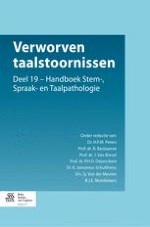Samenvatting
Verschillende effectstudies tonen aan dat bij afasie het herstel met intensieve therapie gunstiger verloopt in vergelijking met alleen spontaan herstel (Wertz e.a., 1986; Poeck e.a., 1989). In de artikelen van Robey (1994) en Holland e.a. (1996) wordt een overzicht gegeven van groeps- en casestudies. Daarnaast wordt een kwalitatieve analyse van het bewijsmateriaal gepresenteerd. Dat tegenwoordig kan worden aangetoond dat afasietherapie een gunstig effect heeft op het herstelverloop, is onder andere te danken aan de wijze waarop de therapiestudies worden opgezet. In tegenstelling tot de groepsstudies uit het verleden wordt er nu meer rekening gehouden met de onderliggende stoornis van de individuele patiënten (Bastiaanse, 2000). Het spreekwoord ‘oefening baart kunst’ gaat bij taaltherapie niet altijd op. Therapie die alleen gericht is op het oefenen van een gestoorde vaardigheid, bijvoorbeeld het benoemen, heeft een zwakke basis (Rothi, 1992). Belangrijk is te bepalen wat met de afasietherapie beoogd wordt. In de literatuur wordt daarin een tweedeling gemaakt.
